The Impact of Prenatal Exposure to Environmental Pollution on Children Development
VerifiedAdded on 2023/01/07
|8
|2209
|28
AI Summary
This report discusses the adverse effects of prenatal exposure to environmental pollution on the growth and development of children. It highlights the risks and potential consequences, and recommends actions to improve air quality and reduce pollution.
Contribute Materials
Your contribution can guide someone’s learning journey. Share your
documents today.
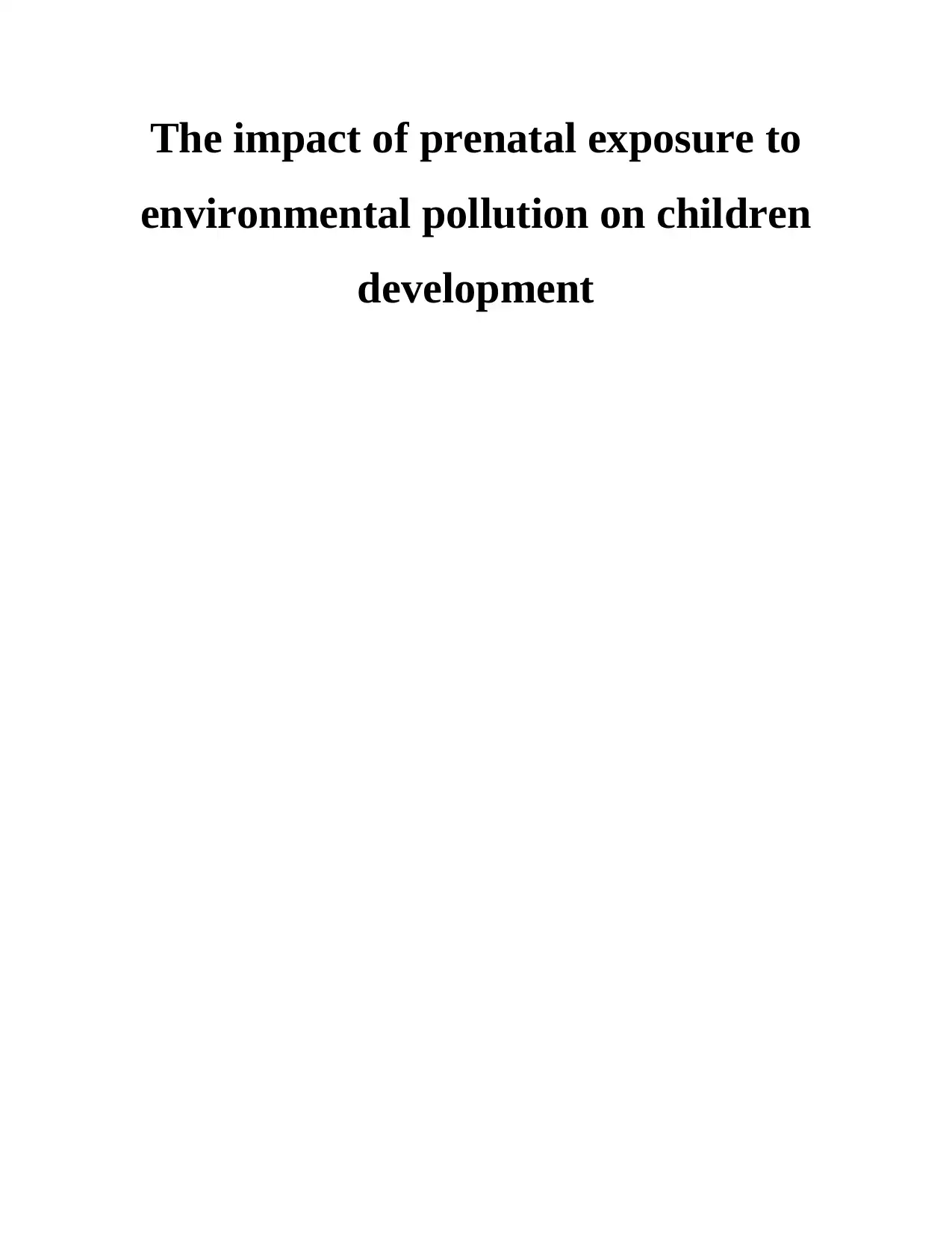
The impact of prenatal exposure to
environmental pollution on children
development
environmental pollution on children
development
Secure Best Marks with AI Grader
Need help grading? Try our AI Grader for instant feedback on your assignments.
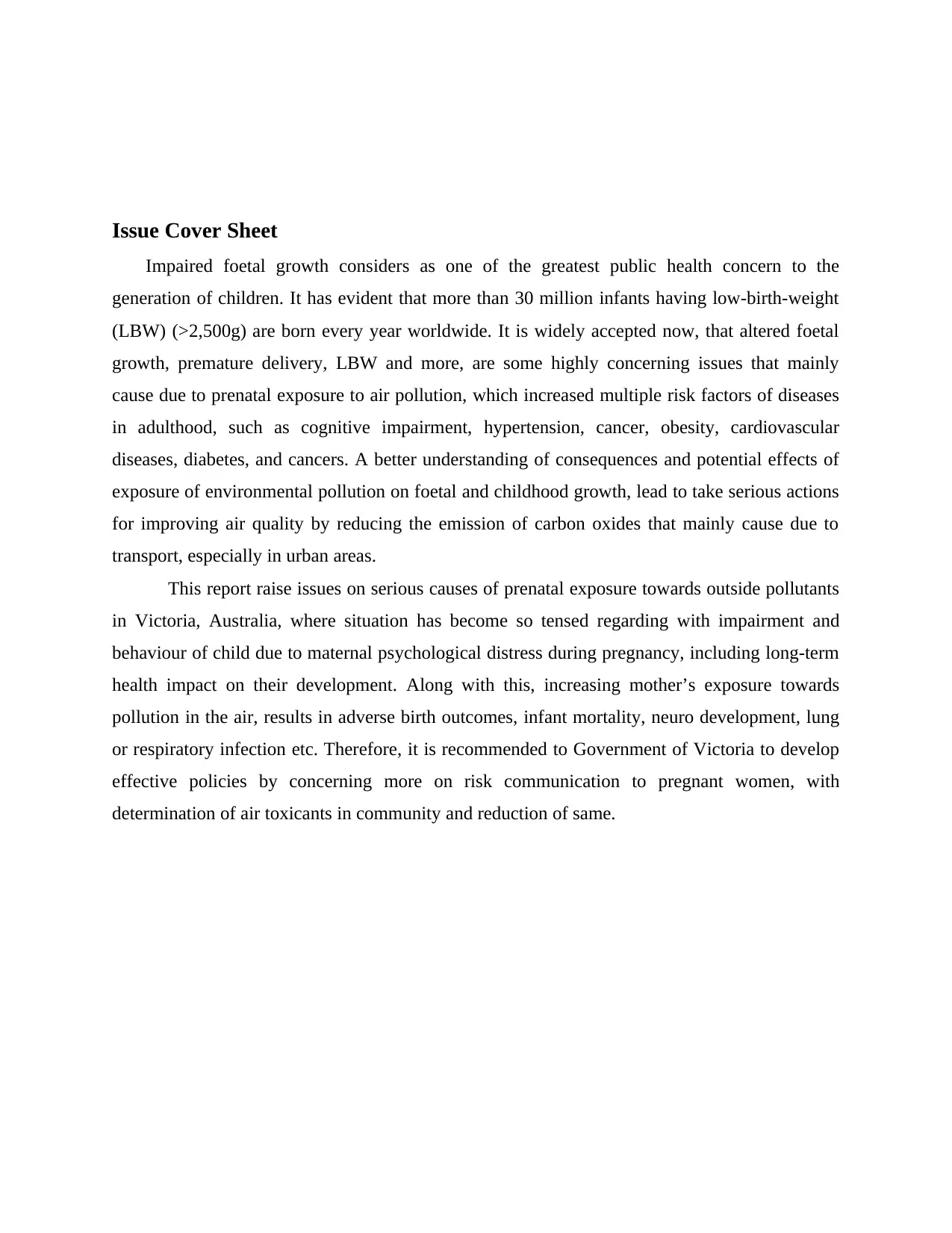
Issue Cover Sheet
Impaired foetal growth considers as one of the greatest public health concern to the
generation of children. It has evident that more than 30 million infants having low-birth-weight
(LBW) (>2,500g) are born every year worldwide. It is widely accepted now, that altered foetal
growth, premature delivery, LBW and more, are some highly concerning issues that mainly
cause due to prenatal exposure to air pollution, which increased multiple risk factors of diseases
in adulthood, such as cognitive impairment, hypertension, cancer, obesity, cardiovascular
diseases, diabetes, and cancers. A better understanding of consequences and potential effects of
exposure of environmental pollution on foetal and childhood growth, lead to take serious actions
for improving air quality by reducing the emission of carbon oxides that mainly cause due to
transport, especially in urban areas.
This report raise issues on serious causes of prenatal exposure towards outside pollutants
in Victoria, Australia, where situation has become so tensed regarding with impairment and
behaviour of child due to maternal psychological distress during pregnancy, including long-term
health impact on their development. Along with this, increasing mother’s exposure towards
pollution in the air, results in adverse birth outcomes, infant mortality, neuro development, lung
or respiratory infection etc. Therefore, it is recommended to Government of Victoria to develop
effective policies by concerning more on risk communication to pregnant women, with
determination of air toxicants in community and reduction of same.
Impaired foetal growth considers as one of the greatest public health concern to the
generation of children. It has evident that more than 30 million infants having low-birth-weight
(LBW) (>2,500g) are born every year worldwide. It is widely accepted now, that altered foetal
growth, premature delivery, LBW and more, are some highly concerning issues that mainly
cause due to prenatal exposure to air pollution, which increased multiple risk factors of diseases
in adulthood, such as cognitive impairment, hypertension, cancer, obesity, cardiovascular
diseases, diabetes, and cancers. A better understanding of consequences and potential effects of
exposure of environmental pollution on foetal and childhood growth, lead to take serious actions
for improving air quality by reducing the emission of carbon oxides that mainly cause due to
transport, especially in urban areas.
This report raise issues on serious causes of prenatal exposure towards outside pollutants
in Victoria, Australia, where situation has become so tensed regarding with impairment and
behaviour of child due to maternal psychological distress during pregnancy, including long-term
health impact on their development. Along with this, increasing mother’s exposure towards
pollution in the air, results in adverse birth outcomes, infant mortality, neuro development, lung
or respiratory infection etc. Therefore, it is recommended to Government of Victoria to develop
effective policies by concerning more on risk communication to pregnant women, with
determination of air toxicants in community and reduction of same.
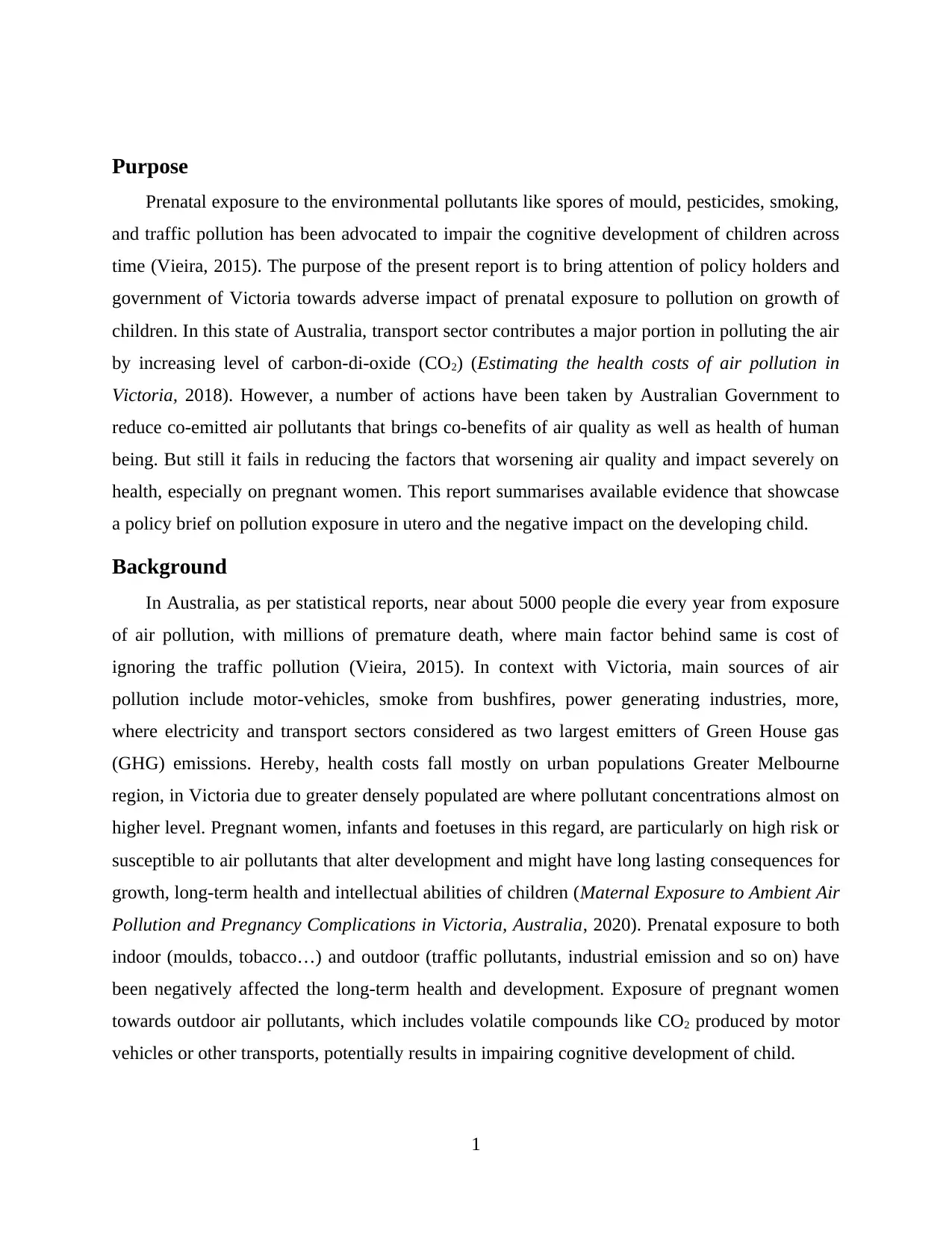
Purpose
Prenatal exposure to the environmental pollutants like spores of mould, pesticides, smoking,
and traffic pollution has been advocated to impair the cognitive development of children across
time (Vieira, 2015). The purpose of the present report is to bring attention of policy holders and
government of Victoria towards adverse impact of prenatal exposure to pollution on growth of
children. In this state of Australia, transport sector contributes a major portion in polluting the air
by increasing level of carbon-di-oxide (CO2) (Estimating the health costs of air pollution in
Victoria, 2018). However, a number of actions have been taken by Australian Government to
reduce co-emitted air pollutants that brings co-benefits of air quality as well as health of human
being. But still it fails in reducing the factors that worsening air quality and impact severely on
health, especially on pregnant women. This report summarises available evidence that showcase
a policy brief on pollution exposure in utero and the negative impact on the developing child.
Background
In Australia, as per statistical reports, near about 5000 people die every year from exposure
of air pollution, with millions of premature death, where main factor behind same is cost of
ignoring the traffic pollution (Vieira, 2015). In context with Victoria, main sources of air
pollution include motor-vehicles, smoke from bushfires, power generating industries, more,
where electricity and transport sectors considered as two largest emitters of Green House gas
(GHG) emissions. Hereby, health costs fall mostly on urban populations Greater Melbourne
region, in Victoria due to greater densely populated are where pollutant concentrations almost on
higher level. Pregnant women, infants and foetuses in this regard, are particularly on high risk or
susceptible to air pollutants that alter development and might have long lasting consequences for
growth, long-term health and intellectual abilities of children (Maternal Exposure to Ambient Air
Pollution and Pregnancy Complications in Victoria, Australia, 2020). Prenatal exposure to both
indoor (moulds, tobacco…) and outdoor (traffic pollutants, industrial emission and so on) have
been negatively affected the long-term health and development. Exposure of pregnant women
towards outdoor air pollutants, which includes volatile compounds like CO2 produced by motor
vehicles or other transports, potentially results in impairing cognitive development of child.
1
Prenatal exposure to the environmental pollutants like spores of mould, pesticides, smoking,
and traffic pollution has been advocated to impair the cognitive development of children across
time (Vieira, 2015). The purpose of the present report is to bring attention of policy holders and
government of Victoria towards adverse impact of prenatal exposure to pollution on growth of
children. In this state of Australia, transport sector contributes a major portion in polluting the air
by increasing level of carbon-di-oxide (CO2) (Estimating the health costs of air pollution in
Victoria, 2018). However, a number of actions have been taken by Australian Government to
reduce co-emitted air pollutants that brings co-benefits of air quality as well as health of human
being. But still it fails in reducing the factors that worsening air quality and impact severely on
health, especially on pregnant women. This report summarises available evidence that showcase
a policy brief on pollution exposure in utero and the negative impact on the developing child.
Background
In Australia, as per statistical reports, near about 5000 people die every year from exposure
of air pollution, with millions of premature death, where main factor behind same is cost of
ignoring the traffic pollution (Vieira, 2015). In context with Victoria, main sources of air
pollution include motor-vehicles, smoke from bushfires, power generating industries, more,
where electricity and transport sectors considered as two largest emitters of Green House gas
(GHG) emissions. Hereby, health costs fall mostly on urban populations Greater Melbourne
region, in Victoria due to greater densely populated are where pollutant concentrations almost on
higher level. Pregnant women, infants and foetuses in this regard, are particularly on high risk or
susceptible to air pollutants that alter development and might have long lasting consequences for
growth, long-term health and intellectual abilities of children (Maternal Exposure to Ambient Air
Pollution and Pregnancy Complications in Victoria, Australia, 2020). Prenatal exposure to both
indoor (moulds, tobacco…) and outdoor (traffic pollutants, industrial emission and so on) have
been negatively affected the long-term health and development. Exposure of pregnant women
towards outdoor air pollutants, which includes volatile compounds like CO2 produced by motor
vehicles or other transports, potentially results in impairing cognitive development of child.
1
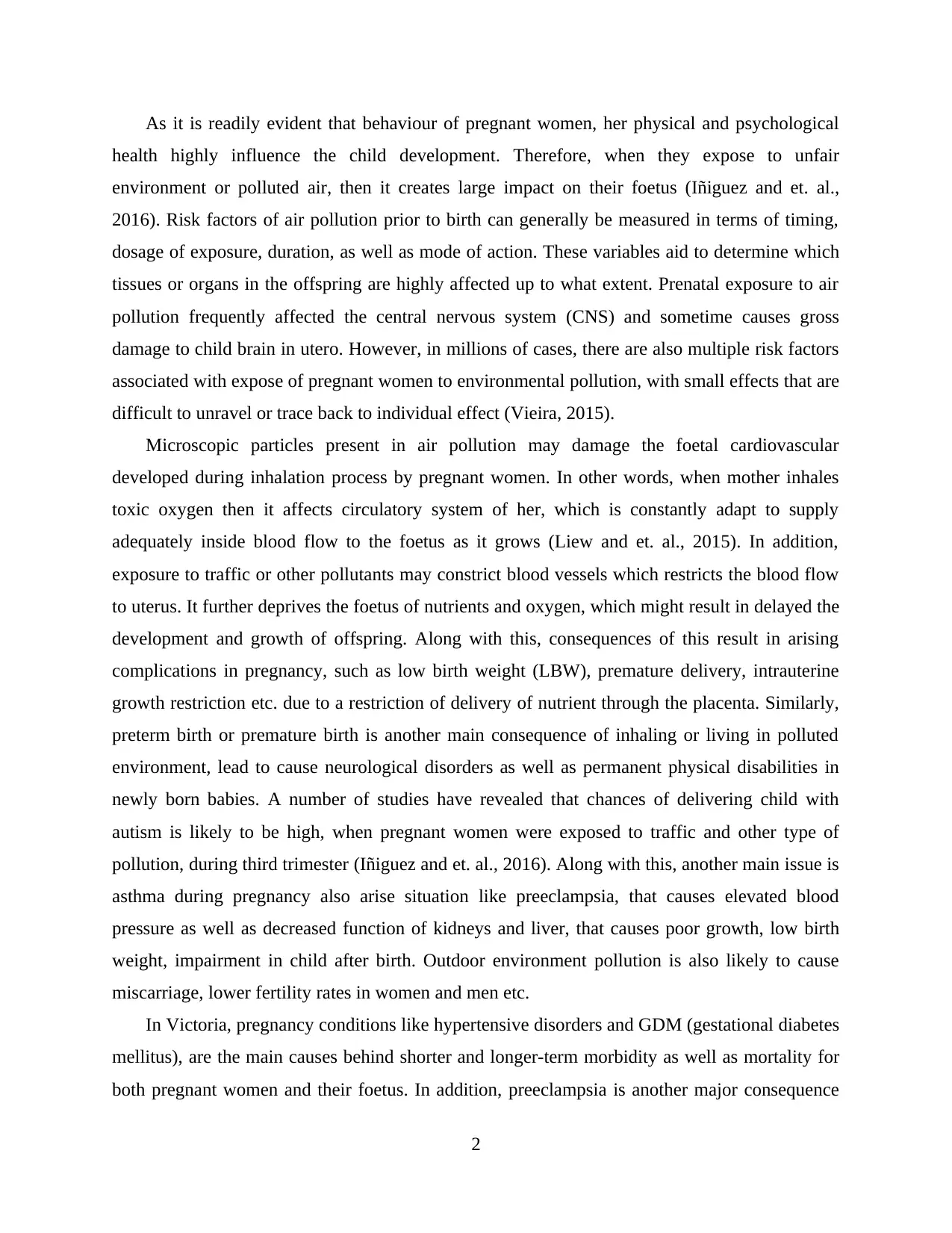
As it is readily evident that behaviour of pregnant women, her physical and psychological
health highly influence the child development. Therefore, when they expose to unfair
environment or polluted air, then it creates large impact on their foetus (Iñiguez and et. al.,
2016). Risk factors of air pollution prior to birth can generally be measured in terms of timing,
dosage of exposure, duration, as well as mode of action. These variables aid to determine which
tissues or organs in the offspring are highly affected up to what extent. Prenatal exposure to air
pollution frequently affected the central nervous system (CNS) and sometime causes gross
damage to child brain in utero. However, in millions of cases, there are also multiple risk factors
associated with expose of pregnant women to environmental pollution, with small effects that are
difficult to unravel or trace back to individual effect (Vieira, 2015).
Microscopic particles present in air pollution may damage the foetal cardiovascular
developed during inhalation process by pregnant women. In other words, when mother inhales
toxic oxygen then it affects circulatory system of her, which is constantly adapt to supply
adequately inside blood flow to the foetus as it grows (Liew and et. al., 2015). In addition,
exposure to traffic or other pollutants may constrict blood vessels which restricts the blood flow
to uterus. It further deprives the foetus of nutrients and oxygen, which might result in delayed the
development and growth of offspring. Along with this, consequences of this result in arising
complications in pregnancy, such as low birth weight (LBW), premature delivery, intrauterine
growth restriction etc. due to a restriction of delivery of nutrient through the placenta. Similarly,
preterm birth or premature birth is another main consequence of inhaling or living in polluted
environment, lead to cause neurological disorders as well as permanent physical disabilities in
newly born babies. A number of studies have revealed that chances of delivering child with
autism is likely to be high, when pregnant women were exposed to traffic and other type of
pollution, during third trimester (Iñiguez and et. al., 2016). Along with this, another main issue is
asthma during pregnancy also arise situation like preeclampsia, that causes elevated blood
pressure as well as decreased function of kidneys and liver, that causes poor growth, low birth
weight, impairment in child after birth. Outdoor environment pollution is also likely to cause
miscarriage, lower fertility rates in women and men etc.
In Victoria, pregnancy conditions like hypertensive disorders and GDM (gestational diabetes
mellitus), are the main causes behind shorter and longer-term morbidity as well as mortality for
both pregnant women and their foetus. In addition, preeclampsia is another major consequence
2
health highly influence the child development. Therefore, when they expose to unfair
environment or polluted air, then it creates large impact on their foetus (Iñiguez and et. al.,
2016). Risk factors of air pollution prior to birth can generally be measured in terms of timing,
dosage of exposure, duration, as well as mode of action. These variables aid to determine which
tissues or organs in the offspring are highly affected up to what extent. Prenatal exposure to air
pollution frequently affected the central nervous system (CNS) and sometime causes gross
damage to child brain in utero. However, in millions of cases, there are also multiple risk factors
associated with expose of pregnant women to environmental pollution, with small effects that are
difficult to unravel or trace back to individual effect (Vieira, 2015).
Microscopic particles present in air pollution may damage the foetal cardiovascular
developed during inhalation process by pregnant women. In other words, when mother inhales
toxic oxygen then it affects circulatory system of her, which is constantly adapt to supply
adequately inside blood flow to the foetus as it grows (Liew and et. al., 2015). In addition,
exposure to traffic or other pollutants may constrict blood vessels which restricts the blood flow
to uterus. It further deprives the foetus of nutrients and oxygen, which might result in delayed the
development and growth of offspring. Along with this, consequences of this result in arising
complications in pregnancy, such as low birth weight (LBW), premature delivery, intrauterine
growth restriction etc. due to a restriction of delivery of nutrient through the placenta. Similarly,
preterm birth or premature birth is another main consequence of inhaling or living in polluted
environment, lead to cause neurological disorders as well as permanent physical disabilities in
newly born babies. A number of studies have revealed that chances of delivering child with
autism is likely to be high, when pregnant women were exposed to traffic and other type of
pollution, during third trimester (Iñiguez and et. al., 2016). Along with this, another main issue is
asthma during pregnancy also arise situation like preeclampsia, that causes elevated blood
pressure as well as decreased function of kidneys and liver, that causes poor growth, low birth
weight, impairment in child after birth. Outdoor environment pollution is also likely to cause
miscarriage, lower fertility rates in women and men etc.
In Victoria, pregnancy conditions like hypertensive disorders and GDM (gestational diabetes
mellitus), are the main causes behind shorter and longer-term morbidity as well as mortality for
both pregnant women and their foetus. In addition, preeclampsia is another major consequence
2
Secure Best Marks with AI Grader
Need help grading? Try our AI Grader for instant feedback on your assignments.
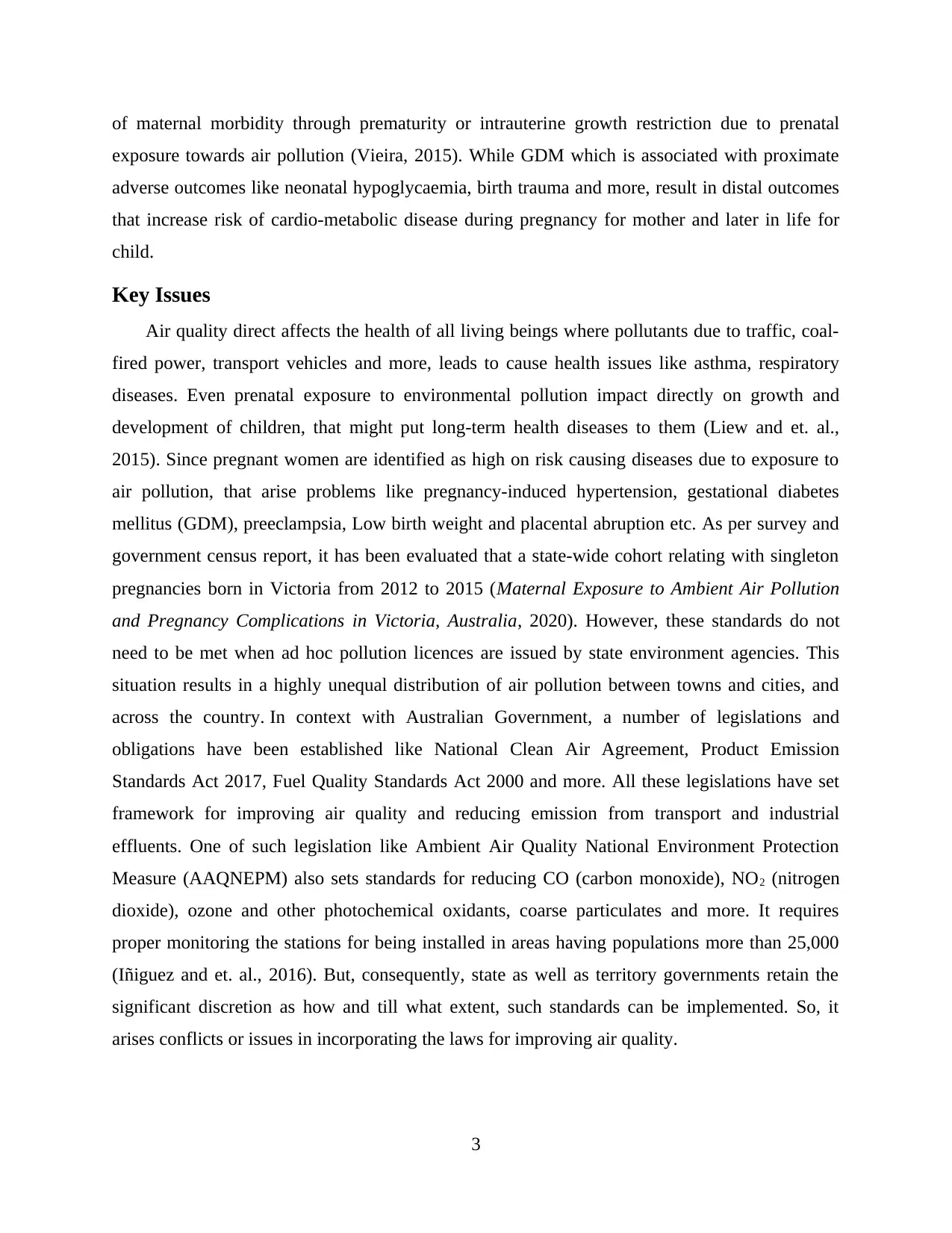
of maternal morbidity through prematurity or intrauterine growth restriction due to prenatal
exposure towards air pollution (Vieira, 2015). While GDM which is associated with proximate
adverse outcomes like neonatal hypoglycaemia, birth trauma and more, result in distal outcomes
that increase risk of cardio-metabolic disease during pregnancy for mother and later in life for
child.
Key Issues
Air quality direct affects the health of all living beings where pollutants due to traffic, coal-
fired power, transport vehicles and more, leads to cause health issues like asthma, respiratory
diseases. Even prenatal exposure to environmental pollution impact directly on growth and
development of children, that might put long-term health diseases to them (Liew and et. al.,
2015). Since pregnant women are identified as high on risk causing diseases due to exposure to
air pollution, that arise problems like pregnancy-induced hypertension, gestational diabetes
mellitus (GDM), preeclampsia, Low birth weight and placental abruption etc. As per survey and
government census report, it has been evaluated that a state-wide cohort relating with singleton
pregnancies born in Victoria from 2012 to 2015 (Maternal Exposure to Ambient Air Pollution
and Pregnancy Complications in Victoria, Australia, 2020). However, these standards do not
need to be met when ad hoc pollution licences are issued by state environment agencies. This
situation results in a highly unequal distribution of air pollution between towns and cities, and
across the country. In context with Australian Government, a number of legislations and
obligations have been established like National Clean Air Agreement, Product Emission
Standards Act 2017, Fuel Quality Standards Act 2000 and more. All these legislations have set
framework for improving air quality and reducing emission from transport and industrial
effluents. One of such legislation like Ambient Air Quality National Environment Protection
Measure (AAQNEPM) also sets standards for reducing CO (carbon monoxide), NO2 (nitrogen
dioxide), ozone and other photochemical oxidants, coarse particulates and more. It requires
proper monitoring the stations for being installed in areas having populations more than 25,000
(Iñiguez and et. al., 2016). But, consequently, state as well as territory governments retain the
significant discretion as how and till what extent, such standards can be implemented. So, it
arises conflicts or issues in incorporating the laws for improving air quality.
3
exposure towards air pollution (Vieira, 2015). While GDM which is associated with proximate
adverse outcomes like neonatal hypoglycaemia, birth trauma and more, result in distal outcomes
that increase risk of cardio-metabolic disease during pregnancy for mother and later in life for
child.
Key Issues
Air quality direct affects the health of all living beings where pollutants due to traffic, coal-
fired power, transport vehicles and more, leads to cause health issues like asthma, respiratory
diseases. Even prenatal exposure to environmental pollution impact directly on growth and
development of children, that might put long-term health diseases to them (Liew and et. al.,
2015). Since pregnant women are identified as high on risk causing diseases due to exposure to
air pollution, that arise problems like pregnancy-induced hypertension, gestational diabetes
mellitus (GDM), preeclampsia, Low birth weight and placental abruption etc. As per survey and
government census report, it has been evaluated that a state-wide cohort relating with singleton
pregnancies born in Victoria from 2012 to 2015 (Maternal Exposure to Ambient Air Pollution
and Pregnancy Complications in Victoria, Australia, 2020). However, these standards do not
need to be met when ad hoc pollution licences are issued by state environment agencies. This
situation results in a highly unequal distribution of air pollution between towns and cities, and
across the country. In context with Australian Government, a number of legislations and
obligations have been established like National Clean Air Agreement, Product Emission
Standards Act 2017, Fuel Quality Standards Act 2000 and more. All these legislations have set
framework for improving air quality and reducing emission from transport and industrial
effluents. One of such legislation like Ambient Air Quality National Environment Protection
Measure (AAQNEPM) also sets standards for reducing CO (carbon monoxide), NO2 (nitrogen
dioxide), ozone and other photochemical oxidants, coarse particulates and more. It requires
proper monitoring the stations for being installed in areas having populations more than 25,000
(Iñiguez and et. al., 2016). But, consequently, state as well as territory governments retain the
significant discretion as how and till what extent, such standards can be implemented. So, it
arises conflicts or issues in incorporating the laws for improving air quality.
3
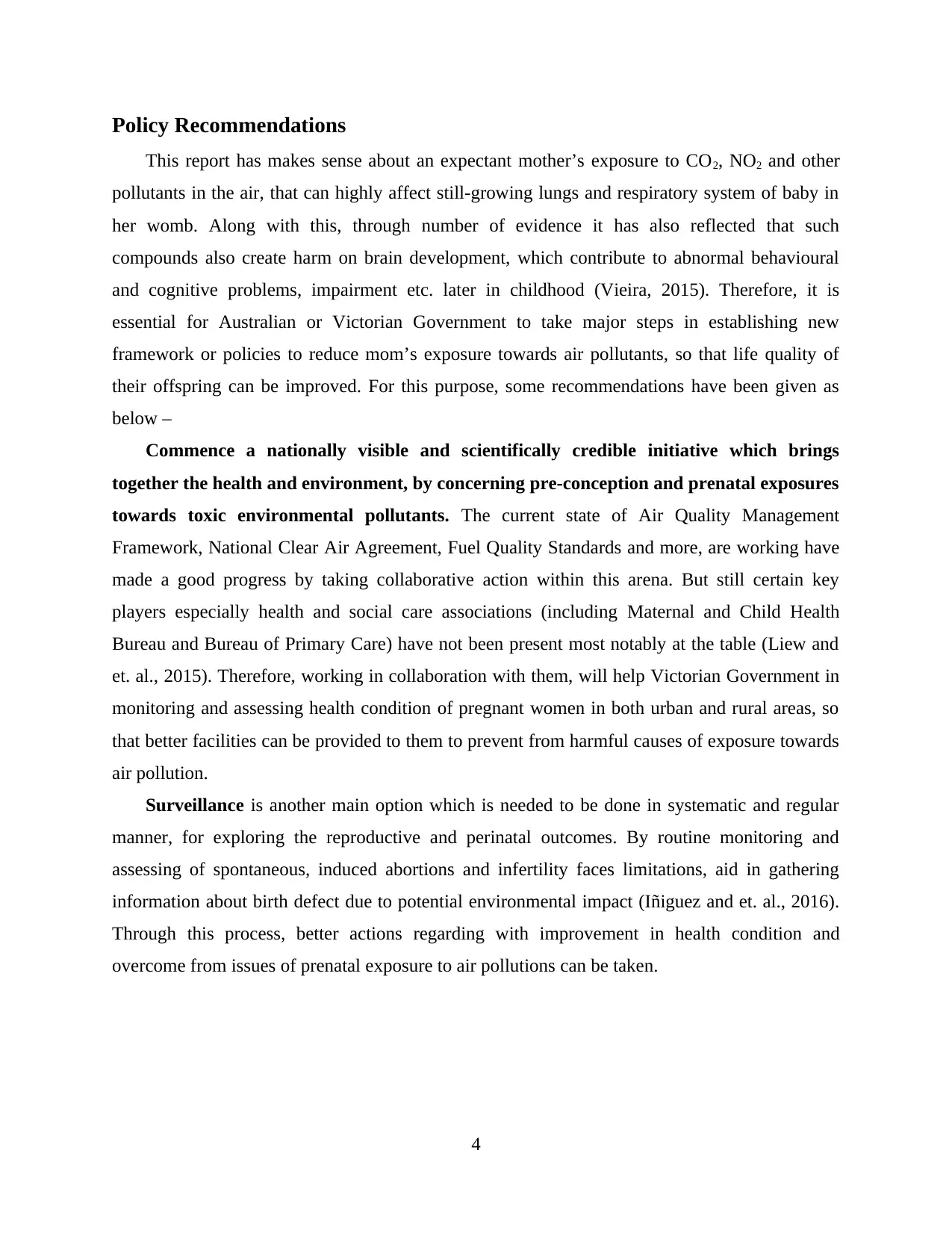
Policy Recommendations
This report has makes sense about an expectant mother’s exposure to CO2, NO2 and other
pollutants in the air, that can highly affect still-growing lungs and respiratory system of baby in
her womb. Along with this, through number of evidence it has also reflected that such
compounds also create harm on brain development, which contribute to abnormal behavioural
and cognitive problems, impairment etc. later in childhood (Vieira, 2015). Therefore, it is
essential for Australian or Victorian Government to take major steps in establishing new
framework or policies to reduce mom’s exposure towards air pollutants, so that life quality of
their offspring can be improved. For this purpose, some recommendations have been given as
below –
Commence a nationally visible and scientifically credible initiative which brings
together the health and environment, by concerning pre-conception and prenatal exposures
towards toxic environmental pollutants. The current state of Air Quality Management
Framework, National Clear Air Agreement, Fuel Quality Standards and more, are working have
made a good progress by taking collaborative action within this arena. But still certain key
players especially health and social care associations (including Maternal and Child Health
Bureau and Bureau of Primary Care) have not been present most notably at the table (Liew and
et. al., 2015). Therefore, working in collaboration with them, will help Victorian Government in
monitoring and assessing health condition of pregnant women in both urban and rural areas, so
that better facilities can be provided to them to prevent from harmful causes of exposure towards
air pollution.
Surveillance is another main option which is needed to be done in systematic and regular
manner, for exploring the reproductive and perinatal outcomes. By routine monitoring and
assessing of spontaneous, induced abortions and infertility faces limitations, aid in gathering
information about birth defect due to potential environmental impact (Iñiguez and et. al., 2016).
Through this process, better actions regarding with improvement in health condition and
overcome from issues of prenatal exposure to air pollutions can be taken.
4
This report has makes sense about an expectant mother’s exposure to CO2, NO2 and other
pollutants in the air, that can highly affect still-growing lungs and respiratory system of baby in
her womb. Along with this, through number of evidence it has also reflected that such
compounds also create harm on brain development, which contribute to abnormal behavioural
and cognitive problems, impairment etc. later in childhood (Vieira, 2015). Therefore, it is
essential for Australian or Victorian Government to take major steps in establishing new
framework or policies to reduce mom’s exposure towards air pollutants, so that life quality of
their offspring can be improved. For this purpose, some recommendations have been given as
below –
Commence a nationally visible and scientifically credible initiative which brings
together the health and environment, by concerning pre-conception and prenatal exposures
towards toxic environmental pollutants. The current state of Air Quality Management
Framework, National Clear Air Agreement, Fuel Quality Standards and more, are working have
made a good progress by taking collaborative action within this arena. But still certain key
players especially health and social care associations (including Maternal and Child Health
Bureau and Bureau of Primary Care) have not been present most notably at the table (Liew and
et. al., 2015). Therefore, working in collaboration with them, will help Victorian Government in
monitoring and assessing health condition of pregnant women in both urban and rural areas, so
that better facilities can be provided to them to prevent from harmful causes of exposure towards
air pollution.
Surveillance is another main option which is needed to be done in systematic and regular
manner, for exploring the reproductive and perinatal outcomes. By routine monitoring and
assessing of spontaneous, induced abortions and infertility faces limitations, aid in gathering
information about birth defect due to potential environmental impact (Iñiguez and et. al., 2016).
Through this process, better actions regarding with improvement in health condition and
overcome from issues of prenatal exposure to air pollutions can be taken.
4
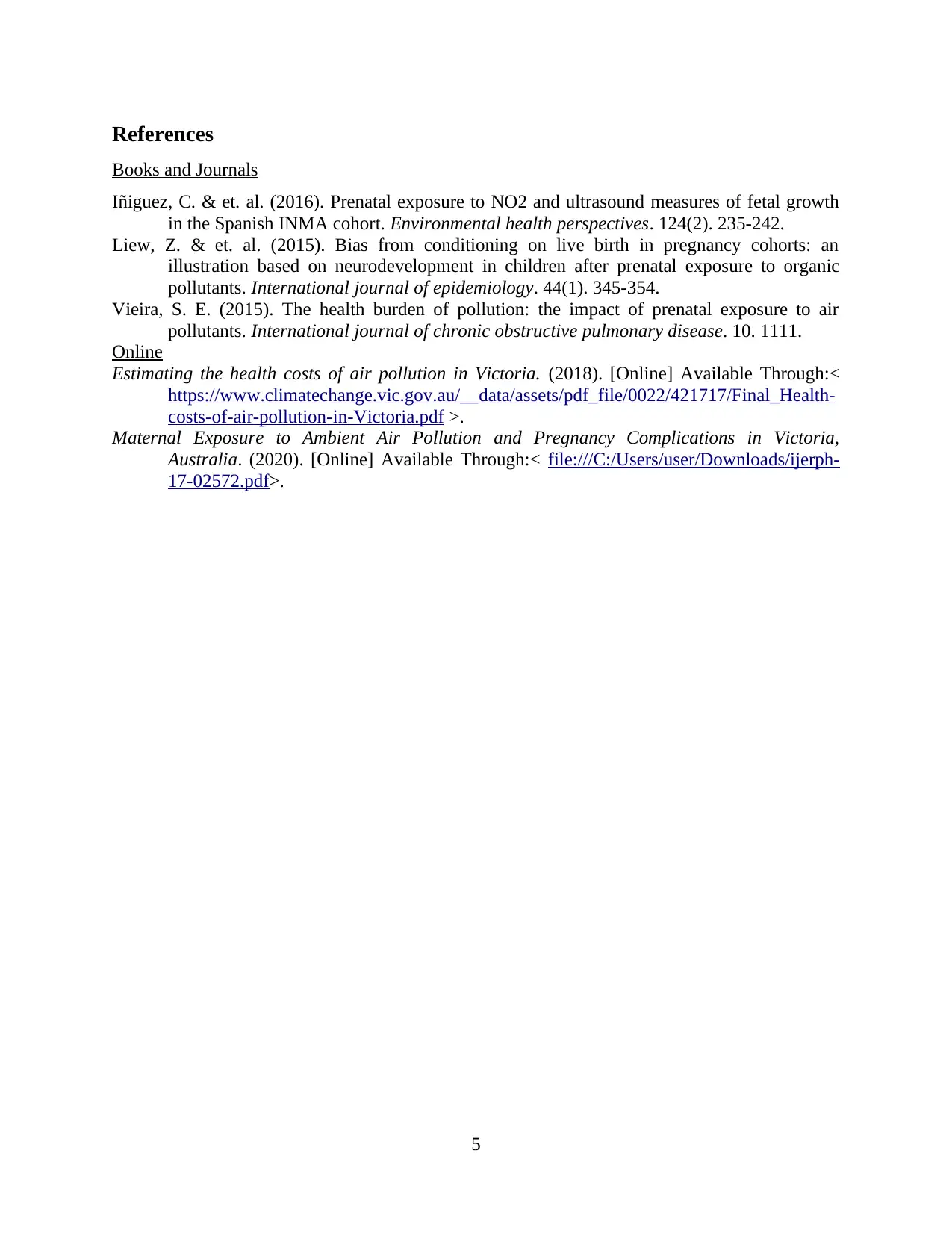
References
Books and Journals
Iñiguez, C. & et. al. (2016). Prenatal exposure to NO2 and ultrasound measures of fetal growth
in the Spanish INMA cohort. Environmental health perspectives. 124(2). 235-242.
Liew, Z. & et. al. (2015). Bias from conditioning on live birth in pregnancy cohorts: an
illustration based on neurodevelopment in children after prenatal exposure to organic
pollutants. International journal of epidemiology. 44(1). 345-354.
Vieira, S. E. (2015). The health burden of pollution: the impact of prenatal exposure to air
pollutants. International journal of chronic obstructive pulmonary disease. 10. 1111.
Online
Estimating the health costs of air pollution in Victoria. (2018). [Online] Available Through:<
https://www.climatechange.vic.gov.au/__data/assets/pdf_file/0022/421717/Final_Health-
costs-of-air-pollution-in-Victoria.pdf >.
Maternal Exposure to Ambient Air Pollution and Pregnancy Complications in Victoria,
Australia. (2020). [Online] Available Through:< file:///C:/Users/user/Downloads/ijerph-
17-02572.pdf>.
5
Books and Journals
Iñiguez, C. & et. al. (2016). Prenatal exposure to NO2 and ultrasound measures of fetal growth
in the Spanish INMA cohort. Environmental health perspectives. 124(2). 235-242.
Liew, Z. & et. al. (2015). Bias from conditioning on live birth in pregnancy cohorts: an
illustration based on neurodevelopment in children after prenatal exposure to organic
pollutants. International journal of epidemiology. 44(1). 345-354.
Vieira, S. E. (2015). The health burden of pollution: the impact of prenatal exposure to air
pollutants. International journal of chronic obstructive pulmonary disease. 10. 1111.
Online
Estimating the health costs of air pollution in Victoria. (2018). [Online] Available Through:<
https://www.climatechange.vic.gov.au/__data/assets/pdf_file/0022/421717/Final_Health-
costs-of-air-pollution-in-Victoria.pdf >.
Maternal Exposure to Ambient Air Pollution and Pregnancy Complications in Victoria,
Australia. (2020). [Online] Available Through:< file:///C:/Users/user/Downloads/ijerph-
17-02572.pdf>.
5
Paraphrase This Document
Need a fresh take? Get an instant paraphrase of this document with our AI Paraphraser

6
1 out of 8
Your All-in-One AI-Powered Toolkit for Academic Success.
+13062052269
info@desklib.com
Available 24*7 on WhatsApp / Email
![[object Object]](/_next/static/media/star-bottom.7253800d.svg)
Unlock your academic potential
© 2024 | Zucol Services PVT LTD | All rights reserved.





